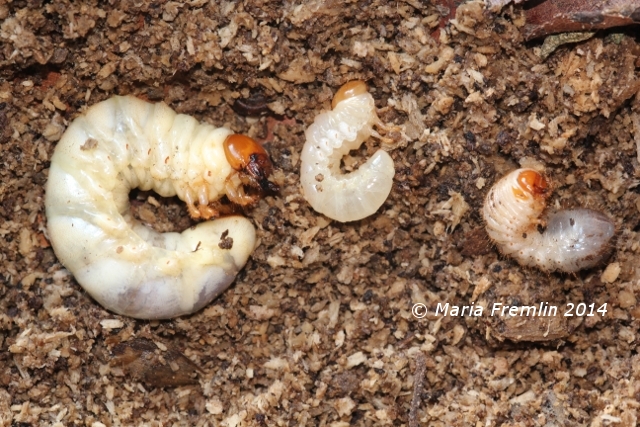
Overwintering third instar larvae. From the left: stag beetle, lesser stag beetle and rose chafer.
Photo by Maria Fremlin. Colchester, Essex, UK. 5 February 2014.

Overwintering third instar larvae. From the left: stag beetle, lesser stag beetle and rose chafer.
Photo by Maria Fremlin. Colchester, Essex, UK. 5 February 2014.
Even though these three detritivore/saproxylic species live close together, a close examination of their gut revealed three different overwintering strategies.
1 - Stag beetle Lucanus cervus larva. Note how dark the body of this larva is; its gut is full of food. The gut is divided in three regions: foregut (hidden under the fat); the midgut is rather large; the hindgut also has three regions: the ileum which is rather large and has a ring of caeca (pouches) in the junction with the midgut; the colon forms an inverted S shape with the rectum which is hidden under the fat.
Dissected overwintering stag beetle larva. Photo Maria Fremlin.
2 - Lesser stag beetle Dorcus parallelipipedus larva. By contrast with the large stag beetle larva on the left in the top picture, the body of this one is almost translucent. This larva has stopped eating. And it has prepared itself for the winter by emptying its whole gut and filling it with a special winter anti-freeze fluid. Even though it is filled with antifreeze its shape is very similar to the stag beetle larva above.
Dissected overwintering lesser stag beetle larva. Photo Maria Fremlin.
3 - Rose chafer Cetonia aurata larva. This larva has quite a different shape; note that its lower abdomen is rather dark. It has also stopped eating, but only its midgut is full of anti-freeze fluid; remarkably, the hindgut remains full; the hindgut is underneath the distended darkened area. See below.
Dissected overwintering rose chafer larva. Photo Maria Fremlin.
Further reading about overwintering strategies and gut morphology:
Edwards EE (1930) On the Morphology of the Larva of Dorcus parallelopipedus, L. (Coleoptera), Zoological Journal of the Linnean Society, 37(251):93–108, https://doi.org/10.1111/j.1096-3642.1930.tb02062.x. [PDF]
Insect winter ecology - in Wikipedia.
Neven LG, Duman JG, Beals JM, Castellino FJ (1986) Overwintering adaptations of the stag beetle, Ceruchus piceus: removal of ice nucleators in the winter to promote supercooling. Journal of Comparative Physiology, 156:707-716.
Xu, L, Neven, LG and Duman, JG (1990) Hormonal control of hemolymph
lipoprotein ice nucleators in overwintering freeze susceptible larvae of the stag beetle Ceruchus piceus: Adipokinetic hormone and juvenile hormone. Journal of Comparative Physiology B, 160:51-59.
Walters KR Jr1, Serianni AS, Voituron Y, Sformo T, Barnes BM, Duman JG. (2011) A thermal hysteresis-producing xylomannan glycolipid antifreeze associated with cold tolerance is found in diverse taxa. Journal of Comparative Physiology B, 181(5):631-40.
Last modified: Sat April 13 2024
| Main | Stag beetles' life cycle | Stag beetle larvae | HELPLINE |